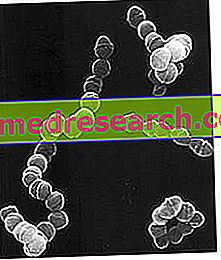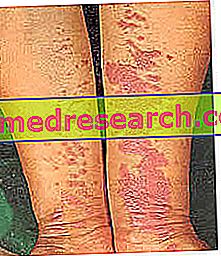Streptococci
Very common in nature, streptococci represent a heterogeneous group of spherical, Gram-positive bacteria; some of these, together with other microorganisms, normally inhabit the mucous membranes of the organism (above all oral, pharyngeal, intestinal and vaginal).

Microbiological description

| NB Staphylococci, dividing along multiple axes, generate clusters of cells. |
The etymological analysis of the term " streptococcus " also suggests the particular "couple" arrangement of these bacteria: the term streptos derives from the Greek "στρεπτος‚ ", which means" easily bent ", just to give the idea of a chain it twists easily.
The streptococcus has a variable diameter from about 0.5 to 1.25 µm and is an optional anaerobic, non-spore and immobile (in most species). These pathogens are gram positive, negative oxidase and negative catalsi.
Most streptococci produce capsules composed of hyaluronic acid, a kind of defense weapon of the bacterium, since it hinders phagocytosis by macrophages and neutrophils.
- Hyaluronic acid is considered an element of virulence of the pathogen, precisely because it delays phagocytosis by the cells of the immune system.
The cell wall is composed of antigens characterized by the letters M (virulence factor endowed with immunogenic power), R (antigen not involved either in virulence, or in immunity) and T (epidemiological marker). In the wall there are also group-specific carbohydrates, peptidoglycans and polysaccharide C. In addition to those just listed, among the virulence factors of streptococcus we also mention the exotoxins (streptolysin O, streptolysin S and erythrogenic toxin) and exoenzymes (hyaluronidase, DNAse, streptokinase and NADase).
General classification
Streptococci can be classified according to two criteria:- behavior on blood agar soils (parameter: haemolytic capacity)
- antigenic structure (in this case, the classification is performed within the group of beta hemolytic streptococci)
Streptococci were classified into three large groups, based on their behavior on blood agar media:
- STREPTOCOCCHI - EMULSIFIED ALPHA: in blood agar soils, this class of streptococci is placed in green colonies, an expression of both incomplete hemolysis and hemoglobin processing (iron hemoglobin oxidation → greenish staining). In this group, streptococci exhibit pili of adhesion (consisting of protein M and covered with lipoteicoic acid) useful for anchoring to the epithelial cells of the host. A typical exponent of this category is the pneumococcus ( S. pneumoniae ).
- STOLF-HEMOLYTIC BETA: cultivated in blood agar soils, these streptococci are placed in colonies surrounded by a rosacea color: the above color is the result of the complete rupture of the red blood cells (eg S. pyogenes )
- STREPTOCOCCHI-EMOLITHIC RANGE (also called anemolytics): they do not generate any haemolysis (eg enterococcus). The term "haemolytic" referring to the group of these pathogens is used improperly.

Structural classification
Depending on the antigenic structure, gram positive streptococci can be further classified: this particular cataloging is called " Lancefield classification ", from the name of the discoverer. Streptococci are thus classified in several serological groups based on the polysaccharide antigen C of cell wall, whose characteristics are extremely heterogeneous in the different types of streptococcus.
| Polysaccharides C: components of the bacterial wall consisting of a fundamental skeleton linked to peptidoglycan. |
The different serum groups are identified by a letter of the alphabet, which goes from A to H and from K to V (in other words, neither group J nor I) exists. Human pathogenic streptococci are members of the serum groups A, B, C, D and G.
Streptococci of pathological interest
In the medical field, the streptococci of greatest pathological interest are certainly the beta-hemolytics of groups A and B, implicated in numerous typically infantile pathologies:
- group A streptococci → pharyngitis, tonsillitis, scarlet fever, pneumonia, rheumatic fever, skin infections and impetigo
- group B streptococci → meningitis, endocarditis, septic arthritis and sepsis
The table shows the most important streptococci from the pathological point of view
| streptococcus | General characteristics | Diseases conveyed |
| Streptococcus pyogenes | Group A beta-hemolytic streptococcus, involved in the vast majority of streptococcal infections in humans | Pharyngitis, acute rheumatic fever, necrotizing fasciitis, nephritis glomerulus, impetigo, scarlet fever |
| Streptococcus agalactiae | Group B hemolytic streptococcus | Systemic bacteremia (rare), meningitis and sepsis in newborns and the elderly |
| Enterococcus faecalis | Non-hemolytic group D streptococcus | Abdominal abscess, endocarditis, bacteremia, urinary tract infection, meningitis |
| Streptococcus pneumoniae | Haemolytic streptococcus alpha | Septic arthritis, bacteremia, endocarditis, meningitis, osteomyelitis, pneumonia, septicemia |
| Streptococci viridans | Haemolytic streptococcus alpha | Abscesses, tooth decay, endocarditis |
The next article will be devoted to the detailed description of streptococci belonging to the beta-hemolytic category.



